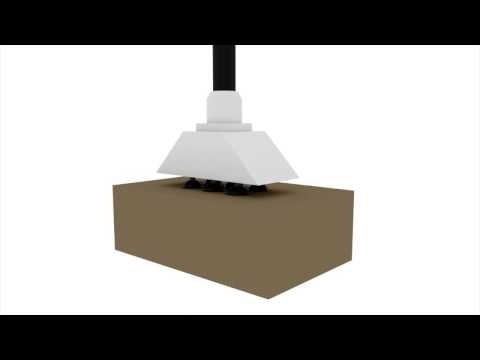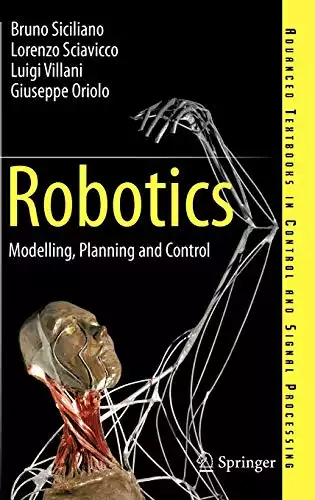Introduction
An end effector in robotics refers to the device at the end of a robotic arm designed to interact with the environment. The exact nature of this interaction is determined by the task the robot is designed to perform.
In Robotics, an end effector is an arm tooling that is attached to the end of a robotic arm. Robot end effectors makes a general purpose robot to perform a particular operation. It acts as the hand of a robot which is directly connected to the last joint. It is an important component of industrial robots which is directly connected to robot wrist. We can think of end effector like a human hand. Imagine you are holding a spoon or pen in your hand. In this case, the spoon and pen become end effectors and they are used to perform a particular operation i.e. eat and write respectively. Robot end effectors are also known as end-of-arm tooling (EOAT) or robot tool.
What are the types of end effectors used in robots?
Even though a human hand is versatile, a robotic end effector has a great advantage that humans don’t have and that is the interchangeability of end effectors. You can have different types of end effectors to perform a wide range of tasks across a wide range of industries. There are mainly three types of end effectors based on their application.
Source: YouTube
Grippers
Gripper end effectors are used to grip certain products or any part or a material and is the most widely used end effector type. In a robot, the function of a robotic gripper is mainly to translate some form of power into a grasping action of the robot arm. The power input is either supplied by pneumatic, hydraulic or electric means. There are various types of grippers and their choice depends on the specific application.
Mechanical gripper: One of the most basic gripper type is the mechanical gripper. They are mechanical fingers which are used to grasp the object. The fingers are also called as gripper jaws. Jaws are actuated by a robot controller to provide the necessary movements to grasp the object. The different type of jaws are Pivot action grippers, Sliding action grippers, Linkage actuation grippers and Cam actuated grippers. Mechanical grippers are cost effective but they may not be able handle irregular shaped objects. They can be further classified based on the type of jaws or fingers used, such as parallel gripper, angular gripper and three-finger gripper.
Magnetic gripper: Magnetic gripper can grasp an iron sheet because of the magnetic action. An adhesion gripper can be used to hold curved objects.
Vacuum gripper: Vacuum gripper is operated by pneumatic cylinders and the vacuum cup is used to grasp the objects and move it to another location. It is used for pick and place operation of objects.
Needle gripper: Needle grippers are used in handling materials that are difficult to grip using vacuum such as textiles, fleece, filter materials, insulation, foam materials, etc.
Pneumatic gripper: Same idea as hydraulic but uses air pressure. It is popular for its compact size, light weight and force. They can be easily incorporated into tight work cells, which can come in handy in a manufacturing process. They have a high ratio of gripping force to weight making them cost effective.
Electric gripper: Each part of the gripper is controlled by wires and motors allowing the gripper to have better control in managing the objects. The wires are pulled as the motor rotates. The more the motor turns the closer the gripper is as opposed to magnetic, vacuum and pneumatic grippers which function in a binary mode i.e. either it is closed or open. Electric grippers allow softer objects to be handled without damaging them.
Intrusive gripper: These grippers work on the principle of force friction and can contain two, three or even five fingers to manage the objects. Applications of intrusive grippers include spot-welding, surgical robotics, spray-painting, etc.
Adhesive gripper: It is one of the simplest forms of grippers and it grasps objects by literally sticking to them. As long as the adhesive keeps its stickiness, the gripper will function without maintenance.
Source: YouTube
Process Tools
Process tool end effectors, also known as process tooling or process end effectors, are specialized end effectors used in industrial manufacturing and automation processes. Below are some common process tool end effectors:
Welding: Welding end effectors are most frequently found in automotive industry where they are used for precise welding and consistency. Generally, welding is performed on clamps or fixtures which are used to holds the parts in place.
Painting: Painting end effector tools are extremely effective as they able to apply consistent amount of paint resulting in a high quality paint job. It also reduces the risk of contamination.
Cutting Tools: These end effectors are equipped with cutting tools, such as blades to perform precision cutting, or shaping. They are commonly used in CNC machines for tasks like material removal or contouring.
Dispensers: Dispensing end effectors are used for precise dispensing or application of liquids, adhesives, or sealants onto work pieces. They may include nozzles, valves, or syringe-like mechanisms to control the flow and volume of the dispensed material.
Also Read: Robotics and manufacturing
Robotic Force Compliance End Effectors
Robotic Force Compliance End Effectors (RFCEE) are specialized tools or devices that enable robots to sense and respond to the reaction or resistance of the object when a force is applied to it. These end effectors provide a level of flexibility in the robot’s movements, allowing it to adapt to uncertain or dynamic conditions.
Force compliance end effectors find applications in various industries, such as manufacturing, assembly, and automation. They are particularly useful in tasks that involve handling delicate or deformable objects, surface finishing, quality inspection, or applications that require precise force control. RFCEE uses springs, hydraulic or pneumatic systems to achieve compliance.
Robotic force compliance end effectors are also beneficial for ensuring safety in human-robot collaboration scenarios. By sensing forces, the robot can detect unexpected collisions or impacts and react accordingly, avoiding injury to humans or damage to the environment. Force compliance end effectors enable robots to operate in close proximity to humans while maintaining safe interaction.
Also Read: STEM Building Toys
Active Compliant Technology
It is important that a robotic hand successfully grasps the objects without damaging them. In order to allow safe grasping, a technique called an active compliance technology is used. Active compliant robots are able to automatically measure the amount of force that needs to be applied. They are also able to offset any sudden counter forces, if objects move for example. It involves incorporating sensors, actuators, and control algorithms that allow the robot to modify its behavior or compliance in real-time to achieve desired tasks.
They utilize internal closed-loop, feedback control along with internal force, acceleration and position sensors to accurately apply the desired force to handle delicate objects. Applications of active compliance technology in robotics include collaborative robots (cobots), physical human-robot interaction, assembly tasks, object manipulation, and even exoskeletons for rehabilitation or assistance.
Passive Technology
While active compliant technology uses sensors, actuators and control algorithms to modify a robot’s behavior, passive technology achieves compliance through mechanical design principles and use of specific materials. Robots are equipped with compliant joints or mechanisms that can passively absorb and distribute forces, allowing the robot to adapt to changes in its environment.
Compliance mechanisms include springs, rubbers, and flexible materials. Passive technology in robotics offers advantages such as simplicity, energy efficiency, and robustness. It allows robots to naturally adapt to unstructured or changing environments without complex control systems. Passive robots can be particularly useful in applications where simplicity, lightweight design, or safety are crucial, such as human-robot interaction, exploration in unknown environments, or delicate object manipulation.
How to choose the right End Effector?
End effector is a critical component of a robotic system and hence choosing the right end effector requires careful consideration of various factors as it can significantly impact the robot’s effectiveness and efficiency. Here are some of the steps you can consider in choosing the right end effector
Application requirements: The first step is to clearly understand the application requirements and the specific tasks the robot will perform. This will require determining the type of object the robot will be dealing with e.g. regular shape, irregular shape, size, weight etc. You will also need to consider the payload capacity and environmental conditions the end effector needs to withstand.
End effector capabilities: Once the application requirements are well understood and finalized, determine the most suitable type of end effector for the application. There are various options available, including mechanical grippers, vacuum grippers, magnetic grippers, suction cups, specialized tools, or even sensors for non-contact interactions. Consider factors like stability, adaptability, precision, and the ability to handle objects of different shapes and sizes. Ensure these end effectors are compatible with the robotic system.
Cost, Maintenance and Repair: Evaluate the cost-effectiveness of different end effector options while considering the desired performance and productivity. Assess factors such as initial investment costs, maintenance requirements, maintenance costs, and the expected lifespan of the end effector. Balance these factors against the benefits gained in terms of efficiency, accuracy, and reliability.
Safety and Compliance: Determine if there are specific compliance requirements, such as cleanliness (e.g., for food or medical applications), safety regulations, or industry standards. Ensure that the end effector design and materials align with these requirements.
Applications of End Effectors
End effectors play a crucial role in various industries and applications. Here are some common applications of end effectors:
Industrial manufacturing: In manufacturing industries; especially in the automotive segment, end effectors are used for tasks such as picking and placing components in an assembly line. Depending on the type of objects to be handled, different end effectors are used. For example, in the automotive industry, end effectors are used to handle various large components such as engines and transmissions as well as to perform tasks such as painting, welding and assembly. They greatly increase efficiency and accuracy in the assembly process thus reducing downtime.
Inspection and Testing: End effectors equipped with sensors and cameras are used to examine products for defects, dimensions and quality checks in a consistent manner.
Medical applications: In the field of medicine, surgical robots are being increasingly used to perform delicate operations. Their precise movements, enhance the capabilities of surgeons thus improving patient outcomes.
Food processing: In the food industry, end effectors are used for tasks like cutting, sorting, slicing, and packaging. This ensures sanitary compliance and also consistent quality and maintaining the brand.
Laboratory automation: In laboratories, end effectors are used to handle samples and vials and perform tasks like transferring samples between different instruments, thus ensuring no contamination occurs.
Agriculture: In agriculture, end effectors are being used to in sowing and harvesting crops, controlled irrigation, and sorting produce. This has helped increase productivity and reduce labor intensive tasks.
Material handing: In warehouses, end effectors are widely used for grasping, lifting, and transporting objects. This is part of the warehouse automation strategy thus optimizing the movement of goods and reducing manual labor.
Future
There are several interesting technology advancements in end effectors that have been crucial in expanding the capabilities of robots and enabling them to perform a wide range of tasks with greater precision and efficiency.
Collaborative Robots (cobots): The advancement of grippers and sensors has enabled collaborative applications wherein the capabilities of workers and robots are leveraged to create synchronized operations. End of Arms Tools (EOAT) is making cobots more reactive and smarter.
Augmented Reality (AR): Augmented Reality has become an effective method to interact with and control robots. The convergence between AR and robots has enabled users to plan precise movements of robot EOAT thus helping users to create control points and define orientation of EOAT linked with each control point
Integration with Machine Learning: Advances in control algorithms and machine learning techniques have enabled end effectors to learn and adapt to various objects and tasks. Robots can now automatically adjust their gripping strategy, optimize force application, or learn from human demonstrations, leading to improved manipulation capabilities and increased efficiency.
Also Read: Cobots: Types of Collaborative Robots and The Future of Teamwork
Key Takeaways
End effectors are crucial components of robotic systems and play a significant role in various industries, including manufacturing, automation, healthcare, and more. As seen above, there are various types of end effectors, including grippers, sensors, and process tools each designed to carry out a certain activity or set of activities. So selecting the right end effector is critical as it can impact the effectiveness and efficiency to a great extent. When designing and implementing end effectors, safety and compliance is a crucial factor. The end effector should be designed to prevent injury to humans, damage to objects, or any potential hazards.
Also Read: AI and Autonomous Driving
Conclusion
End effectors are vital components of robotic applications, serving as the interface between robots and the surrounding environment. Their functionality, customizability, and interchangeability make them versatile tools that enhance the flexibility and efficiency of robotic operations. As technology continues to advance, end effectors will play an increasingly critical role in driving automation, productivity, and innovation in various fields, shaping the future of robotics and industrial processes.
References
Kelly, Rafael, et al. Control of Robot Manipulators in Joint Space. Springer Science & Business Media, 2006.
Lynch, Kevin M., and Frank C. Park. Modern Robotics. Cambridge University Press, 2017.
McKinnon, Peter. Robotics: Everything You Need to Know about Robotics from Beginner to Expert. Createspace Independent Publishing Platform, 2016.
Siciliano, Bruno, et al. Robotics: Modelling, Planning and Control. Springer Science & Business Media, 2010.











